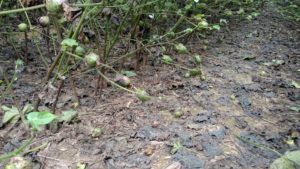Authored by Heather M. Kelly, Extension Plant Pathologist and Tyson Raper, Cotton and Small Grains Specialist
The abnormally warm and wet conditions in the Mid-South during August have contributed to the highest level of target spot-driven defoliation in commercial fields to date. Still, the majority of Tennessee’s cotton will not see a yield penalty from the disease due to a late onset and very low levels of defoliation. However, the warm and wet conditions during August in conjunction with excessive rates of nitrogen, high planting rates, narrow rows, and/or rank growth have resulted in defoliation in excess of 50% on a limited number of acres. Within confined areas of a small percentage of these fields, large boll drop has been confirmed (see images below). This boll abortion phenomenon appears to be caused by a lack of supporting resources for developing bolls low in the canopy as a result of excessive defoliation caused by target spot. Aborting bolls are typically:
- Second position fruit
- Located on first or second fruiting branch (nodes 6-9)
- Vary in size from a quarter to slightly larger
- Are immature at the time of abortion (estimated at 14-20 days of age; no seed coat color, still have jelly in seed, are easy to cut with a sharp knife).
- Are a minimum of 5 nodes away from the nearest leaf (either subtending or mainstem) remaining on the plant.
The vast majority of fields that have >50% defoliation from target spot are NOT seeing boll drop and the fields in Tennessee with boll drop that have been scouted by UT Specialists are still only estimated to have a limited yield loss from the boll abortion.
The reasoning behind the low estimate for loss is based on two main factors. First, mature bolls are not shedding from the plant and immature bolls in the upper canopy do not appear to be shedding. Second, the abortion is occurring on plants with a tremendous fruit load; there are typically 6-10 additional bolls on the plant from which the boll aborts. Remember, much of TN’s crop entered August with an exceptional boll load (refer to the ‘Cotton turning . . . too soon’ for more information on this topic).
Again, while many cotton fields in the Mid-South have target spot lesions in them, it is not expected that every field will have yield loss and even fields with substantial defoliation from target spot and other maladies like boll rot and boll drop, catastrophic yield loss is not expected.

To summarize and add to some facts about target spot from the previous article ‘Target spot in cotton – the knowns and unknowns’ posted at news.utcrops.com on August 16:
- Target spot is caused by the fungal pathogen Corynespora cassiicola which causes lesions with irregular concentric rings. More concerning than the lesions of target spot is the premature defoliation it causes, which starts in the lower canopy.
- No variety resistance has been identified but target spot is more severe where a dense canopy is allowed to develop.
- While the disease is responsive to fungicides, lint yield responses from fungicide applications have been variable. Generally, Tennessee research trials have shown one or two applications at or around the third week of bloom can increase yields over the untreated check by reducing disease incidence and reducing defoliation.
- Fungicide applications applied after physiological cutout (NAWF 5) may decrease defoliation but are not recommended because they will often fail to protect yields.
Things to think about for next season…
The disease flourishes in a humid canopy. Although we cannot manipulate the weather, we can manipulate the environment in which the plant grows. To reduce canopy humidity:
- Consider planting within the lower range of UT recommended seeding rates, especially if hill-dropped or on narrow row spacing (less than 36”).
- Do not over apply N (the most recommended for TN cotton is 80 lb).
- Aggressively manage plant growth. If unable to quickly address vigorous growth from in-season measurements, select a variety which is more responsive to PGRs and begin applying PGRs prior to bloom.
- If in narrow row spacing, consider a 2-skip-1 pattern to increase airflow through the canopy.
Lastly, scouting for and correctly identifying the start of disease and determining if protection with a fungicide is needed based on the growth of the plant, weather conditions, and potential yield will be crucial to guide disease management decisions.

